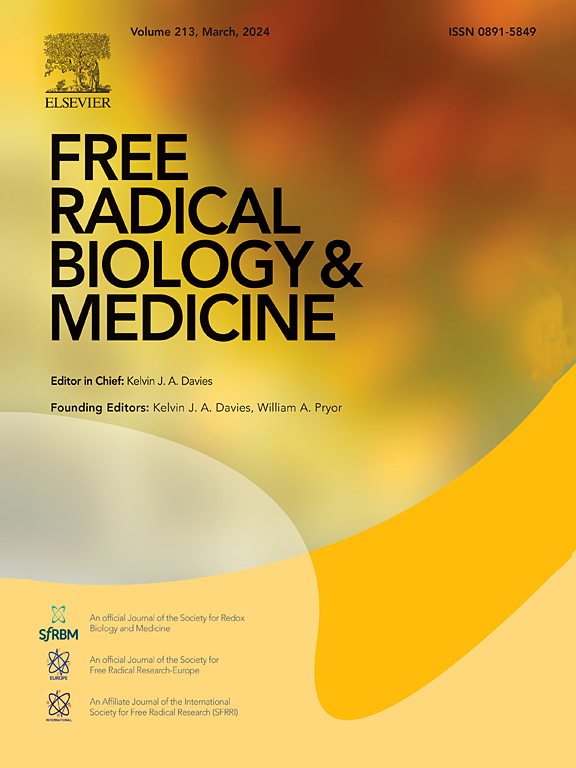Hydrogen peroxide diffusion across the red blood cell membrane occurs mainly by simple diffusion through the lipid fraction
IF 7.1
2区 生物学
Q1 BIOCHEMISTRY & MOLECULAR BIOLOGY
引用次数: 0
Abstract
Hydrogen peroxide (H2O2) is an oxidant produced endogenously by several enzymatic pathways. While it can cause molecular damage, H2O2 also plays a role in regulating cell proliferation and survival through redox signaling pathways. In the vascular system, red blood cells (RBCs) are notably efficient at metabolizing H2O2. In addition to a robust antioxidant defense, we recently determined that human RBCs also have a high membrane permeability to H2O2 that is independent of aquaporin 1 or aquaporin 3. In this work, we sought to further investigate the permeation mechanism of H2O2 through the membrane of human RBCs. First, we explored the role of other erythrocytic membrane proteins in H2O2 transport, including urea transporter B and ammonia transporter Rh proteins. However, no differences were found in H2O2 permeability in RBCs lacking these proteins compared to control RBCs. We then focused on the hypothesis that H2O2 diffuses through the lipid bilayer. To test this, we studied H2O2 permeability in RBCs from patients with Gaucher disease (GD), which accumulate sphingolipids in the membrane, affecting RBC morphology and deformability. We found that RBCs from GD patients exhibited lower H₂O₂ membrane permeability. In another approach, we treated normal RBCs with hexanol, which fluidizes the lipid fraction of the RBC membrane, and observed an increase in the permeability to H2O2. In contrast, hexanol had no effect on the rate of water efflux by aquaporin 1. Together, these results support the hypothesis that H2O2 diffusion through the RBC membrane occurs primarily through the lipid fraction.

过氧化氢在红细胞膜上的扩散主要是通过脂质部分的简单扩散进行的。
过氧化氢(H2O2)是一种由多种酶途径产生的内源性氧化剂。H2O2 在造成分子损伤的同时,还能通过氧化还原信号途径调节细胞的增殖和存活。在血管系统中,红细胞(RBC)代谢 H2O2 的效率非常高。除了强大的抗氧化防御能力外,我们最近还发现人类红细胞对 H2O2 具有很高的膜渗透性,这种渗透性与水蒸素 1 或水蒸素 3 无关。首先,我们探讨了其他红细胞膜蛋白在 H2O2 转运中的作用,包括尿素转运体 B 和氨转运体 Rh 蛋白。然而,与对照红细胞相比,缺乏这些蛋白的红细胞的 H2O2 通透性没有差异。随后,我们重点研究了 H2O2 通过脂质双分子层扩散的假设。为了验证这一假设,我们研究了戈谢病(GD)患者的红细胞对 H2O2 的通透性,戈谢病患者的细胞膜中会积聚鞘磷脂,从而影响红细胞的形态和变形能力。我们发现戈谢病患者的红细胞表现出较低的氢₂O₂膜通透性。在另一种方法中,我们用正己醇处理正常红细胞,观察到其对 H2O2 的通透性增加。这些结果共同支持了 H2O2 主要通过脂质部分在 RBC 膜上扩散的假设。
本文章由计算机程序翻译,如有差异,请以英文原文为准。
求助全文
约1分钟内获得全文
求助全文
来源期刊

Free Radical Biology and Medicine
医学-内分泌学与代谢
CiteScore
14.00
自引率
4.10%
发文量
850
审稿时长
22 days
期刊介绍:
Free Radical Biology and Medicine is a leading journal in the field of redox biology, which is the study of the role of reactive oxygen species (ROS) and other oxidizing agents in biological systems. The journal serves as a premier forum for publishing innovative and groundbreaking research that explores the redox biology of health and disease, covering a wide range of topics and disciplines. Free Radical Biology and Medicine also commissions Special Issues that highlight recent advances in both basic and clinical research, with a particular emphasis on the mechanisms underlying altered metabolism and redox signaling. These Special Issues aim to provide a focused platform for the latest research in the field, fostering collaboration and knowledge exchange among researchers and clinicians.
 求助内容:
求助内容: 应助结果提醒方式:
应助结果提醒方式:


